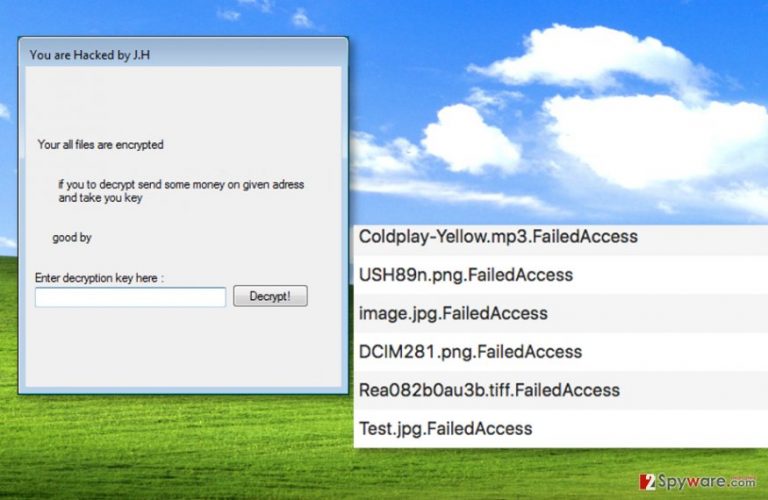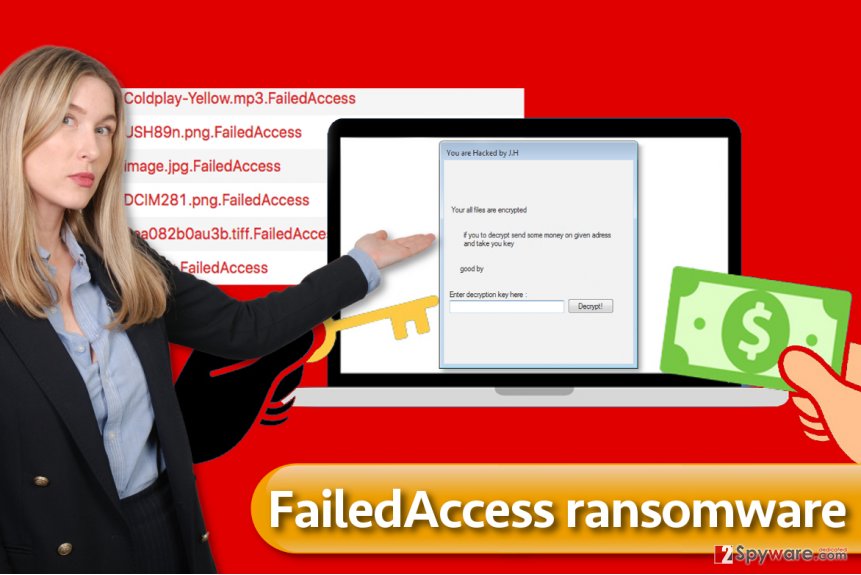FailedAccess ransomware / virus (Recovery Instructions Included)
FailedAccess virus Removal Guide
What is FailedAccess ransomware virus?
FailedAccess ransomware itself is a foolish virus that was defeated already
FailedAccess virus is a computer virus that is also known under CryptoSomware virus name. It is yet another open-source ransomware based[1] malware variant that encrypts files on Desktop\projet sans fils\test folder only. During the encryption, the malicious program marks each file with .FailedAccess file extension. It seeks to corrupt all kinds of important records, such as documents, photos, videos, and audio files. The reason why this virus targets only one location on the computer is that it is a test version of the virus. However, even before the ransomware managed to emerge in public, malware analysts released a decryptor for it. The decryptor is called Stupid Decryptor, and it works for other poorly-programmed HiddenTear spin-offs such as JeepersCrypt, SnakeEye, and others.

The virus displays a window called “You are Hacked by J.H,” which says:
Your all files are encrypted
If you to decrypt send some money on given address and take you key
Good by
The ransomware is clearly created by someone who lacks programming and of course English-speaking skills, because not only the virus’ code, but also the message left for the victim is full of mistakes. If your PC was infected, you should remove FailedAccess malware immediately with the help of software that is capable of deleting ransomware-type viruses; therefore we recommend using FortectIntego or Malwarebytes software. After deleting the virus, you can use the decryptor that is described at the end of the article, right below FailedAccess removal tutorial.

Learn how this virus spreads
Ransomware-type[2] viruses usually spread via malicious spam[3], and if we think about the banality of this virus, it is clear that its developer simply isn’t experienced enough to employ advanced malware distribution techniques such as exploit kits[4] or malvertising[5]. Therefore, the biggest chance to infect your PC with such or similar low-level ransomware virus is to open an email attachment or link sent by someone you don’t know. We suggest you carefully look at the email address of the sender every time someone sends you an email message before even opening it. You must realize that legitimate emails sent by reputable companies usually have company’s name after @ sign, and scammers try to create similar-looking fakes just to convince the victim to open them. For example, joshua-amazon-support@india.com doesn’t actually work at Amazon. Keep that in mind and stay clear of such deceptive emails that deliver malware-laden attachments.
Remove FailedAccess ransomware
If your computer has been compromised, we have no doubts that you are looking for a way to remove FailedAccess virus the easiest and fastest way possible. Therefore, there are no doubts that the safest and quickest method to exterminate the malicious software is to run a system check with professional malware removal software. For this case, our team recommends using the FortectIntego software. Before you run it, begin FailedAccess removal by rebooting your computer according to this tutorial we provided.
Getting rid of FailedAccess virus. Follow these steps
Manual removal using Safe Mode
First of all, get rid of the virus. Here’s the right way to do it.
Important! →
Manual removal guide might be too complicated for regular computer users. It requires advanced IT knowledge to be performed correctly (if vital system files are removed or damaged, it might result in full Windows compromise), and it also might take hours to complete. Therefore, we highly advise using the automatic method provided above instead.
Step 1. Access Safe Mode with Networking
Manual malware removal should be best performed in the Safe Mode environment.
Windows 7 / Vista / XP
- Click Start > Shutdown > Restart > OK.
- When your computer becomes active, start pressing F8 button (if that does not work, try F2, F12, Del, etc. – it all depends on your motherboard model) multiple times until you see the Advanced Boot Options window.
- Select Safe Mode with Networking from the list.

Windows 10 / Windows 8
- Right-click on Start button and select Settings.

- Scroll down to pick Update & Security.

- On the left side of the window, pick Recovery.
- Now scroll down to find Advanced Startup section.
- Click Restart now.

- Select Troubleshoot.

- Go to Advanced options.

- Select Startup Settings.

- Press Restart.
- Now press 5 or click 5) Enable Safe Mode with Networking.

Step 2. Shut down suspicious processes
Windows Task Manager is a useful tool that shows all the processes running in the background. If malware is running a process, you need to shut it down:
- Press Ctrl + Shift + Esc on your keyboard to open Windows Task Manager.
- Click on More details.

- Scroll down to Background processes section, and look for anything suspicious.
- Right-click and select Open file location.

- Go back to the process, right-click and pick End Task.

- Delete the contents of the malicious folder.
Step 3. Check program Startup
- Press Ctrl + Shift + Esc on your keyboard to open Windows Task Manager.
- Go to Startup tab.
- Right-click on the suspicious program and pick Disable.

Step 4. Delete virus files
Malware-related files can be found in various places within your computer. Here are instructions that could help you find them:
- Type in Disk Cleanup in Windows search and press Enter.

- Select the drive you want to clean (C: is your main drive by default and is likely to be the one that has malicious files in).
- Scroll through the Files to delete list and select the following:
Temporary Internet Files
Downloads
Recycle Bin
Temporary files - Pick Clean up system files.

- You can also look for other malicious files hidden in the following folders (type these entries in Windows Search and press Enter):
%AppData%
%LocalAppData%
%ProgramData%
%WinDir%
After you are finished, reboot the PC in normal mode.
Remove FailedAccess using System Restore
-
Step 1: Reboot your computer to Safe Mode with Command Prompt
Windows 7 / Vista / XP- Click Start → Shutdown → Restart → OK.
- When your computer becomes active, start pressing F8 multiple times until you see the Advanced Boot Options window.
-
Select Command Prompt from the list

Windows 10 / Windows 8- Press the Power button at the Windows login screen. Now press and hold Shift, which is on your keyboard, and click Restart..
- Now select Troubleshoot → Advanced options → Startup Settings and finally press Restart.
-
Once your computer becomes active, select Enable Safe Mode with Command Prompt in Startup Settings window.

-
Step 2: Restore your system files and settings
-
Once the Command Prompt window shows up, enter cd restore and click Enter.

-
Now type rstrui.exe and press Enter again..

-
When a new window shows up, click Next and select your restore point that is prior the infiltration of FailedAccess. After doing that, click Next.


-
Now click Yes to start system restore.

-
Once the Command Prompt window shows up, enter cd restore and click Enter.
Bonus: Recover your data
Guide which is presented above is supposed to help you remove FailedAccess from your computer. To recover your encrypted files, we recommend using a detailed guide prepared by 2-spyware.com security experts.If your files are encrypted by FailedAccess, you can use several methods to restore them:
Use StupidDecrypter to decrypt your files
Malware analyst Michael Gillespie has created a tool called StupidDecrypter to address all poorly-programmed ransomware viruses. This tool is powerful enough to decrypt files marked with .powned, .nazi, .killedxxx, .failedaccess, .deria, .devil, android, .snakeeye, and some other file extensions.
Finally, you should always think about the protection of crypto-ransomwares. In order to protect your computer from FailedAccess and other ransomwares, use a reputable anti-spyware, such as FortectIntego, SpyHunter 5Combo Cleaner or Malwarebytes
How to prevent from getting ransomware
Protect your privacy – employ a VPN
There are several ways how to make your online time more private – you can access an incognito tab. However, there is no secret that even in this mode, you are tracked for advertising purposes. There is a way to add an extra layer of protection and create a completely anonymous web browsing practice with the help of Private Internet Access VPN. This software reroutes traffic through different servers, thus leaving your IP address and geolocation in disguise. Besides, it is based on a strict no-log policy, meaning that no data will be recorded, leaked, and available for both first and third parties. The combination of a secure web browser and Private Internet Access VPN will let you browse the Internet without a feeling of being spied or targeted by criminals.
No backups? No problem. Use a data recovery tool
If you wonder how data loss can occur, you should not look any further for answers – human errors, malware attacks, hardware failures, power cuts, natural disasters, or even simple negligence. In some cases, lost files are extremely important, and many straight out panic when such an unfortunate course of events happen. Due to this, you should always ensure that you prepare proper data backups on a regular basis.
If you were caught by surprise and did not have any backups to restore your files from, not everything is lost. Data Recovery Pro is one of the leading file recovery solutions you can find on the market – it is likely to restore even lost emails or data located on an external device.
- ^ Jornt van der Wiel. Hidden tear and its spin offs. Securelist. Information about Viruses, Hackers and Spam.
- ^ Ransomware facts. Microsoft. Malware Protection Center.
- ^ Darya Gudkova, Maria Vergelis, Nadezhda Demidova, Tatyana Shcherbakova. Spam and phishing in 2016. Securelist. Information about Viruses, Hackers and Spam.
- ^ Exploit Kit. Trend Micro USA. Threat Encyclopedia.
- ^ Alex Hern. Major sites including New York Times and BBC hit by 'ransomware' malvertising. The Guardian. News, sport and opinion from the Guardian's US edition.







